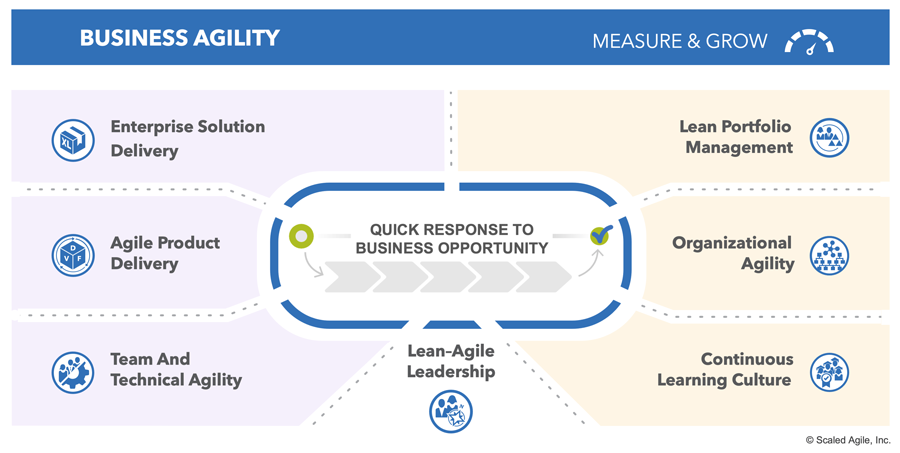In this blog series, we are taking a quick look at each of the 12 steps in the SAFe Implementation Roadmap. Previously, we discussed Extending SAFe to the Portfolio Level. Today we will discuss how to accelerate your SAFe journey as our final article.
We’re nearly at the finish. It has been a long journey. If your organization completed all previous 11 steps in the SAFe implementation journey, you should be in good shape. Your change agents, SAFe Program Consultants (SPCs), Lean-Agile Leaders, and Lean Agile Center of Excellence (LACE) are now all in place. You have also trained most stakeholders and executives. You and your team have broken down your organization’s portfolio to various value streams and ARTs. You have applied the SAFe framework throughout all levels of the organization, from individual agile teams up to executives managing the portfolio.
And you are seeing results! Improvements in your solution’s quality are more than noticeable. Your teams are more productive than ever before and they are delivering faster while increasing engagement in their work.
All that is left to do is put the icing on the cake. Right?
Not quite.
In order to realize true business agility, the organization needs to take the wins from the individual and program increments and begin to apply them to the long-term vision of the company.
According to the SAFe website, there are five ways that the organization can use to ensure relentless improvement:
- Measure the performance of the portfolio
- Reinforce the basics
- Progress towards mastery
- Anchor new behaviors in culture
- Apply learnings across the enterprise
We will discuss each of these in the next few sections and achieve true business agility.
Measure the Performance of the Portfolio
Make your good better and your better best is the theme for this section. SAFe has helped you improve already, that is for sure. But where has it helped you improve the most? The least? Time to reflect and make your good improvements even better and use the best improvements to continue greatness.
In order to measure some of this, it might make sense to rate yourself on each of the seven core competencies we’ve been talking about. SAFe also mentions different dimensions for each competency if you want to go into more detail.
Reinforce the Basics
In our previous article, Launch More Value Streams and ARTs, we recommended restarting the implementation roadmap from “Identify Value Streams and ARTs” for each additional ART. This is because, as we start to launch more and more ARTs, we will begin to face bigger challenges and might lose some of our basic principles.
The experts at Scaled Agile have created a subset of Essential SAFe that outlines the ten critical factors for ART success. These are the ten factors that need to be assessed and reassessed as you continue to implement more ARTs.
Progress Towards Mastery
If we have reinforced the basics and measured the success of our various ARTs at the portfolio level, we are ready for our next step which is to progress towards mastery. The most straightforward way to become a SAFe master is to focus on the seven core competencies.
- Team and Technical Agility
- Agile Product Delivery
- Enterprise Solution Delivery
- Lean Portfolio Management
- Lean-Agile Leadership
- Organizational Agility
- Continuous Learning culture
In this SAFe article, the team at Scaled Agile offer three or four pro tips for each competency. Once you feel your team has mastered the basics, we recommend taking a look at these tips in order to really accelerate your SAFe implementation.
Anchor New Behaviors in Culture
In this step we can really start to cement our new way of working within the organizational culture. The leaders who lead the change need to take this step personally. They are the defenders of the new way of working.
When things begin to get difficult with the new way of working and old habits and processes start to rear their heads, it is the leaders who need to show the rest of the team that the new way of working is the way to go. How do they act when times get tough? What do they say? Do they go back to the old way of working?
There will constantly be threats to your SAFe implementation. Employee and leadership turnover is one of them. New market threats is another. Culture persists all of that. If the seven core competencies of SAFe are alive and embedded in your organization, you cannot fail from outside threats.
Apply Learnings Across the Enterprise
There are a number of organizations in the world that have more than one portfolio. After extending the SAFe framework to the portfolio level, it makes sense to now extend that even further to the enterprise level.
However a brief word of caution, just because one portfolio was successful, does not mean that all the others will be. The recommended route to take here is to use your existing SPCs from the initial portfolio in the new portfolios. They can take their learnings and findings and use them in their next implementation. They need to start from the beginning, but at least now they have some experience implementing SAFe in the organization.
This concludes our blog series on the SAFe implementation roadmap. We hope you enjoyed following along with us as we worked through some of typical SAFe implementation best practices. As we mentioned in every article, if you have any questions or need any help, please feel free to reach out to us at Seibert Media. We would love to hear from you.



